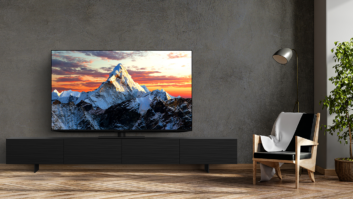Tom Edwards (NPD Group): In the fourth quarter retailers and manufacturers drove consumers into the stores by advertising low prices, which, unfortunately, came out of margins in many cases. So it was a difficult holiday period.
Ray Brown (Sears): The customers were out shopping for value and it put pressure on premium brands and big-ticket items. To a certain degree we saw sales shift out of premium brands even within the same category, down to some of these third- or fourth-tier brands.
If a low-end brand, many of which were Chinese-made, said “digital,” the customer was voting that this must be of reasonable quality. They may not have heard of a name like Sansui, Sylvania or Apex, but if it said “digital” and the value proposition was 33 cents on the dollar relative to a brand they have heard of, they tried that piece.
It’s a retailer’s worst nightmare on the day after Thanksgiving to see a shopping cart filled with nothing but Sylvania and Apex going through the cash register. But they voted that way with their pocketbooks.
All of us are now looking for signs that the customer can move beyond that in 2003. The compression is something we face every year and most of us know it is going to take a 10 percent to 15 percent unit increase in many cases to realize a dollar increase. Not many of us can make money selling $39 DVD players. We need HD, plasma, cellular and satellite working.
Rick Souder (Circuit City): That’s going to be interesting to sort out because it can have significant implications for the type of assortment each of us chooses, how we present it to the customer, and what brands do or do not perform well. I don’t know whether it will take three months or three years to play out, but it will be a big challenge for all of us.
It’s an acceleration of a trend we’ve seen before, where the middle gets smaller and smaller, and it seemed to accelerate much faster as we went through the holiday season.
Bob Lawrence (AVB/BrandSource): We saw exactly what Rick described: Our high-end business and low-end business were both way up, but what used to be the fat middle is now the skinny middle. Our mid-line business is down to about 15 percent of our total CE business, whereas it used to be the biggest part.
We’re seeing some big transitions in terms of what is going to happen in CE and where we are going to go. The companies in the mid-line are the ones that I think are going to be faced with some real significant problems in the next few years.
Dave Workman (Ultimate Electronics): The middle got sucked out of the market.
There really wasn’t a problem with the high-end sales; there just weren’t enough of them. As you look at a bell curve, you miss that really sweet spot in the upper middle, where a huge amount of our operation’s volume is. That’s why certain types of retailers like us probably fared a little worse then some others.
Frank Sadowski (Amazon.com): Commoditization is really a problem and there is no question that it was more difficult to sell better brands. One thing that happens when products become commodities is that the lower-end products get to be higher quality. A $79 VCR player today is a pretty good VCR, and that is happening across the board.
We all expect that each year certain products will become more commoditized, although it seems to happen faster and faster. A lot of our profitability, especially in value-added retail, has always relied on there being a new aspirational product behind it where we can make some money. There certainly are now, with LCD and plasma TV, but there is a gap in there. They have not become mainstream enough to fill in the devastation that was done by DVD players becoming a third of the price that they were two years ago.
Brown: We had somebody pitch us our first DVD player in a blister pack that you hang on a pegboard. You know it has turned to commoditization when you start blister-packing DVD players.
Jeff Stone (Tweeter): I agree totally that there was price compression. One of the problems with this industry is that we do things like sell DVD players for $59, $69 or $99. We are all out there beating each other’s heads out and then we sit around a table like this and wonder what happened to the season. Every single day, every single year, we do it ourselves. We cheapen the value of what we sell.
I don’t want to get on a soapbox, but some of us sell stuff at less than it costs us and then wonder why we’re not making any money, or why we have to do 33 percent more in units to break even with last year.
TWICE: Yet Tweeter held the line and was punished for its efforts by Wall Street.
Stone: I don’t care about being punished, because we run the business for the business, not Wall Street. My view is that when the ducks are not flying, why try to drive it with additional ad spend? Why cut your prices to chase volume? I know there are other people in the market share game, be we’re not.
Our margins were strong and we don’t have a huge margin erosion problem. But we didn’t go chasing the business, so sales were down 10 percent for the quarter. That is the trade-off.
In a consultative selling approach, I think it is difficult to have a philosophy of going to market and saying, “O.K, for these 10 days you can discount the hell out of everything.” Then on January 1, you try to say, “Now you have to hold the line on prices again.” It is a very difficult thing to do. If anybody knows how to do it, let me know.
TWICE: Three-hour, Black Friday door buster specials certainly don’t help.
Workman: They’re O.K. to do, just as long as you’re the only one doing it. So if you guys would just cut that out …
Brown: It’s the springboard to the season and arguably the most read pre-print flyer of the entire year, the one that gets spread out on the living room table for a couple hours that Thursday morning of Thanksgiving.
You have to be where you have to be. None of us wants to lead the industry down. But if that is where the industry is going to be, then we need to find a way to be there.
Jerry Throgmartin (H.H Gregg): We were all sitting there trying to anticipate what was going to happen six to eight weeks ahead of time. We were looking at an economy that was not that great and trying to figure where we had to be to see footsteps. Our experience was that we saw many footsteps Thanksgiving weekend. And then it slowed dramatically.
Sadowski: We can all sing the blues about the average price of DVDs, but at the same time people are also buying 17 movies in the first year, when the original prediction was that they would buy four.
From an application standpoint, our product is fabulously popular and people are very interested in expanding the application. It is healthy to focus on the products that enable them to do that, rather than worry so much about commoditization of goods.
One of our founding principles is that if you start at the customer and work back, you will always come out all right in the end. Computers are soft, but are people more or less interested in the applications that they can provide? We are never going to stop commoditization, although sometimes we may accelerate it a little too fast.













